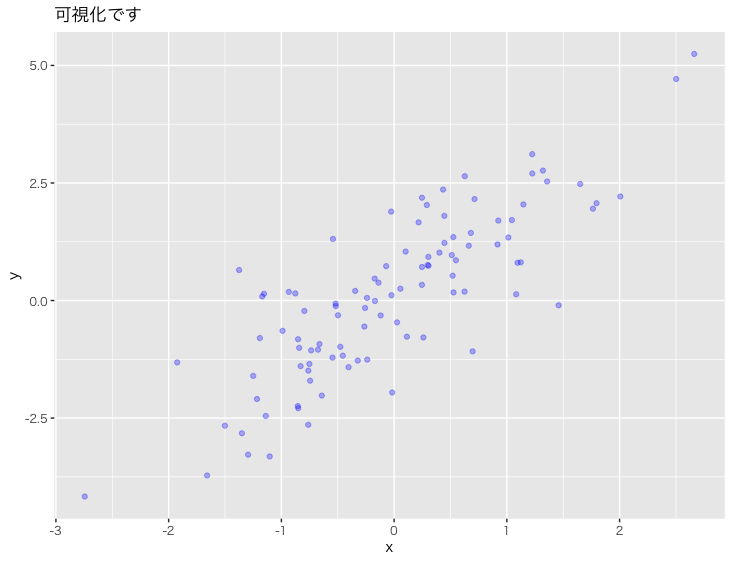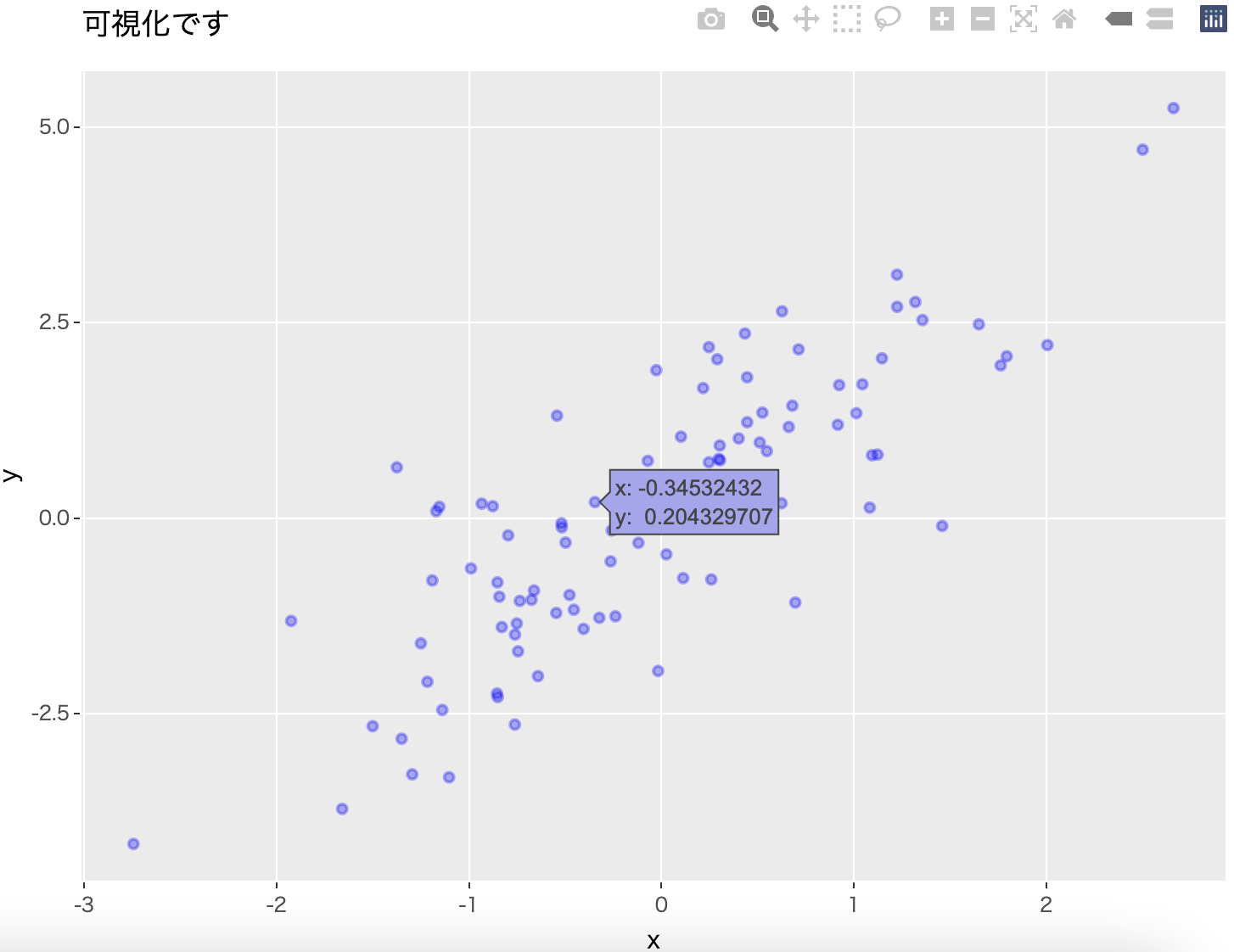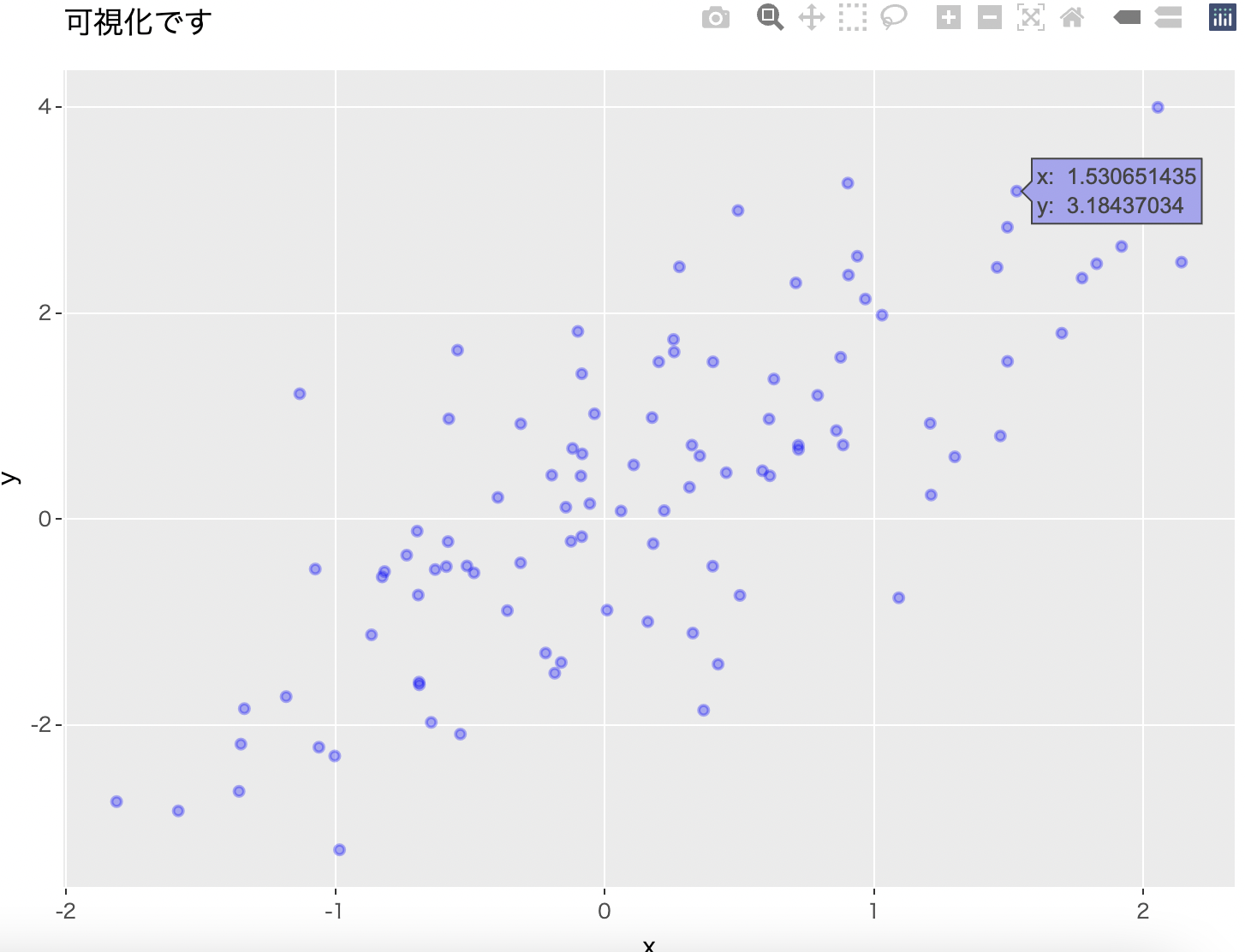はじめに
この記事では、R言語の仕様について少し深い話をします。
内容は前の記事に関連するので、興味ある方は読んでみてください:
あれ?パイプがいうことを聞いてくれない、、、
やりたいことは簡単です。
> g <- tibble::tibble(
x = rnorm(100)
) |>
dplyr::mutate(
noise = rnorm(dplyr::n())
) |>
dplyr::mutate(
y = 1.2 * x + noise
) |>
ggplot2::ggplot() +
ggplot2::geom_point(ggplot2::aes(x = x, y = y), color = ggplot2::alpha("blue", 0.3)) +
ggplot2::ggtitle("可視化です") +
ggplot2::theme_gray(base_family = "HiraKakuPro-W3")
> g
再現性はあまり本質的ではないので、seed関連は省略します。ごめんなさい。
このggplot2のグラフをplotlyのインタラクティブなグラフにしたいだけです:
> plotly::ggplotly(g)
でも、わざわざgという中間変数を設定するのではなく、直接パイプでつなげたいですね。こんな感じで:
> tibble::tibble(
x = rnorm(100)
) |>
dplyr::mutate(
noise = rnorm(dplyr::n())
) |>
dplyr::mutate(
y = 1.2 * x + noise
) |>
ggplot2::ggplot() +
ggplot2::geom_point(ggplot2::aes(x = x, y = y), color = ggplot2::alpha("blue", 0.3)) +
ggplot2::ggtitle("可視化です") +
ggplot2::theme_gray(base_family = "HiraKakuPro-W3") |>
plotly::ggplotly()
Error in UseMethod("ggplotly", p) :
no applicable method for 'ggplotly' applied to an object of class "c('theme', 'gg')"
あれ、、、エラーが、、、
抽象構文木で挙動を確認する
ではまず、上のエラーを引き起こしたRのコードは一体どんな順序で実行されたのかを見てみます。
Rのlobstrパッケージにそのまま調べたいコードを渡せば抽象構文木を可視化してくれます。
> lobstr::ast(
tibble::tibble(
x = rnorm(100)
) |>
dplyr::mutate(
noise = rnorm(dplyr::n())
) |>
dplyr::mutate(
y = 1.2 * x + noise
) |>
ggplot2::ggplot() +
ggplot2::geom_point(ggplot2::aes(x = x, y = y), color = ggplot2::alpha("blue", 0.3)) +
ggplot2::ggtitle("可視化です") +
ggplot2::theme_gray(base_family = "HiraKakuPro-W3") |>
plotly::ggplotly()
)
█─`+`
├─█─`+`
│ ├─█─`+`
│ │ ├─█─█─`::`
│ │ │ │ ├─ggplot2
│ │ │ │ └─ggplot
│ │ │ └─█─█─`::`
│ │ │ │ ├─dplyr
│ │ │ │ └─mutate
│ │ │ ├─█─█─`::`
│ │ │ │ │ ├─dplyr
│ │ │ │ │ └─mutate
│ │ │ │ ├─█─█─`::`
│ │ │ │ │ │ ├─tibble
│ │ │ │ │ │ └─tibble
│ │ │ │ │ └─x = █─rnorm
│ │ │ │ │ └─100
│ │ │ │ └─noise = █─rnorm
│ │ │ │ └─█─█─`::`
│ │ │ │ ├─dplyr
│ │ │ │ └─n
│ │ │ └─y = █─`+`
│ │ │ ├─█─`*`
│ │ │ │ ├─1.2
│ │ │ │ └─x
│ │ │ └─noise
│ │ └─█─█─`::`
│ │ │ ├─ggplot2
│ │ │ └─geom_point
│ │ ├─█─█─`::`
│ │ │ │ ├─ggplot2
│ │ │ │ └─aes
│ │ │ ├─x = x
│ │ │ └─y = y
│ │ └─color = █─█─`::`
│ │ │ ├─ggplot2
│ │ │ └─alpha
│ │ ├─"blue"
│ │ └─0.3
│ └─█─█─`::`
│ │ ├─ggplot2
│ │ └─ggtitle
│ └─"可視化です"
└─█─█─`::`
│ ├─plotly
│ └─ggplotly
└─█─█─`::`
│ ├─ggplot2
│ └─theme_gray
└─base_family = "HiraKakuPro-W3"
なるほど、どうやらggplot2の最後の
ggplot2::theme_gray(base_family = "HiraKakuPro-W3") |>
plotly::ggplotly()
が先に実行されちゃったようです。
簡単な事例
では、前回の記事でも述べたように、「+」は普通の関数なので、抽象構文木に慣れていない方のために、まずはより簡単な事例で+とパイプの実行順序を見ましょう。
まず、このコードについて考えてみてください:
1 + 5 |> sin() + 2 |> exp()
さて、sin関数に入るのは5なのか、それとも6(つまり5 + 1)なのか?
答えを見ましょう!
> 1 + 5 |> sin() + 2 |> exp()
[1] 7.430132
> lobstr::ast(1 + 5 |> sin() + 2 |> exp())
█─`+`
├─█─`+`
│ ├─1
│ └─█─sin
│ └─5
└─█─exp
└─2
なるほど、5が先にsin関数に入れられてから、+関数を呼び出して1とsin(5)の足し算を実行しました。
なので、パイプ演算子の優先順位は+より高いことがわかりました。
ではどうしても6をsin関数に入れたいときはどうすればいいのかというと、()で囲めばいいです。
> (1 + 5) |> sin() + 2 |> exp()
[1] 7.109641
> lobstr::ast((1 + 5) |> sin() + 2 |> exp())
█─`+`
├─█─sin
│ └─█─`(`
│ └─█─`+`
│ ├─1
│ └─5
└─█─exp
└─2
()関数(そう、カッコも実は関数なんですよ)のおかげで1と5の間の足し算がsin関数より先に実行されました。
なので普通の数式の計算のように、()で先に実行する計算を囲めば、実行順序を変えられます。
解決方法
では、早速やってみましょう:
> (
tibble::tibble(
x = rnorm(100)
) |>
dplyr::mutate(
noise = rnorm(dplyr::n())
) |>
dplyr::mutate(
y = 1.2 * x + noise
) |>
ggplot2::ggplot() +
ggplot2::geom_point(ggplot2::aes(x = x, y = y), color = ggplot2::alpha("blue", 0.3)) +
ggplot2::ggtitle("可視化です") +
ggplot2::theme_gray(base_family = "HiraKakuPro-W3")
) |>
plotly::ggplotly()
できました!
抽象構文木も確認しましょう:
> lobstr::ast(
(
tibble::tibble(
x = rnorm(100)
) |>
dplyr::mutate(
noise = rnorm(dplyr::n())
) |>
dplyr::mutate(
y = 1.2 * x + noise
) |>
ggplot2::ggplot() +
ggplot2::geom_point(ggplot2::aes(x = x, y = y), color = ggplot2::alpha("blue", 0.3)) +
ggplot2::ggtitle("可視化です") +
ggplot2::theme_gray(base_family = "HiraKakuPro-W3")
) |>
plotly::ggplotly()
)
█─█─`::`
│ ├─plotly
│ └─ggplotly
└─█─`(`
└─█─`+`
├─█─`+`
│ ├─█─`+`
│ │ ├─█─█─`::`
│ │ │ │ ├─ggplot2
│ │ │ │ └─ggplot
│ │ │ └─█─█─`::`
│ │ │ │ ├─dplyr
│ │ │ │ └─mutate
│ │ │ ├─█─█─`::`
│ │ │ │ │ ├─dplyr
│ │ │ │ │ └─mutate
│ │ │ │ ├─█─█─`::`
│ │ │ │ │ │ ├─tibble
│ │ │ │ │ │ └─tibble
│ │ │ │ │ └─x = █─rnorm
│ │ │ │ │ └─100
│ │ │ │ └─noise = █─rnorm
│ │ │ │ └─█─█─`::`
│ │ │ │ ├─dplyr
│ │ │ │ └─n
│ │ │ └─y = █─`+`
│ │ │ ├─█─`*`
│ │ │ │ ├─1.2
│ │ │ │ └─x
│ │ │ └─noise
│ │ └─█─█─`::`
│ │ │ ├─ggplot2
│ │ │ └─geom_point
│ │ ├─█─█─`::`
│ │ │ │ ├─ggplot2
│ │ │ │ └─aes
│ │ │ ├─x = x
│ │ │ └─y = y
│ │ └─color = █─█─`::`
│ │ │ ├─ggplot2
│ │ │ └─alpha
│ │ ├─"blue"
│ │ └─0.3
│ └─█─█─`::`
│ │ ├─ggplot2
│ │ └─ggtitle
│ └─"可視化です"
└─█─█─`::`
│ ├─ggplot2
│ └─theme_gray
└─base_family = "HiraKakuPro-W3"
これで問題なく、ggplot2のオブジェクトを丸ごとplotly::ggplotlyの第一引数として渡せました。
結論
以前の記事でも強調したのですが、Rはいわゆる「統計ソフト」ではなく、JavaScript、Go、Python、Scalaと同じように、普通のプログラミング言語です。ウェブサイトとAPIの構築、ユーザーの操作ログ追跡、並びにスクレイピングも自由自在にできる普通の一言語として、開発者はその言語仕様をしっかり理解しないといけません。
あ、そうです、ちなみにRはデータ分析もできます。ちなみに。
Rの場合、実行順序に不安がある場合、まずはlobstr::astで抽象構文木を覗いてみることをお勧めします。


